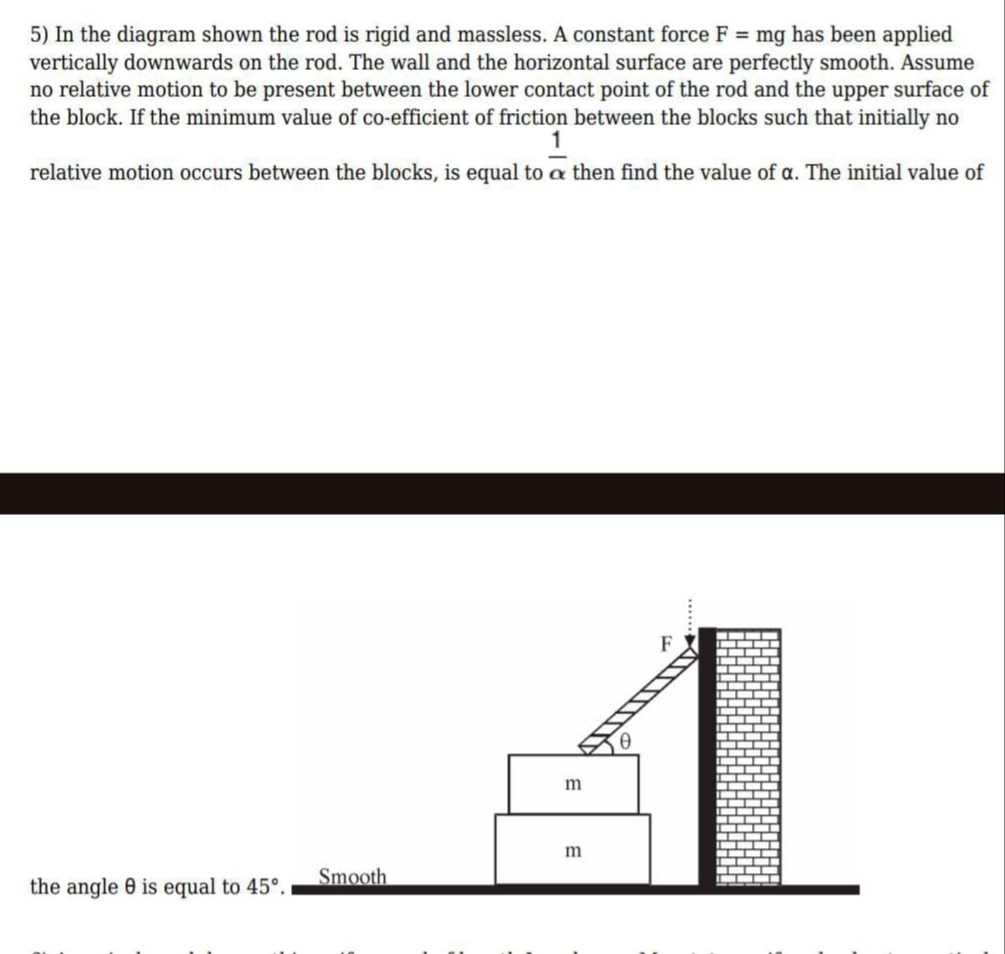Question
Question: In the diagram shown the rod is rigid and massless. A constant force F = mg has been applied vertica...
In the diagram shown the rod is rigid and massless. A constant force F = mg has been applied vertically downwards on the rod. The wall and the horizontal surface are perfectly smooth. Assume no relative motion to be present between the lower contact point of the rod and the upper surface of the block. If the minimum value of co-efficient of friction between the blocks such that initially no relative motion occurs between the blocks, is equal to α then find the value of α. The initial value of the angle θ is equal to 45°.

1/2
1
2
4
1/2
Solution
-
Forces on the Rod: Let the rod be in equilibrium. Let NA be the normal reaction from the wall at point A (top end) and F=mg be the applied force downwards at A. Let the force exerted by the upper block on the rod at point B (lower end) be R. Since the upper block's surface is horizontal, R can be resolved into a vertical component NB_on_rod (upwards) and a horizontal component fB_on_rod (horizontal).
-
Vertical Equilibrium of the Rod: NB_on_rod−F=0⟹NB_on_rod=F=mg.
-
Horizontal Equilibrium of the Rod: NA+fB_on_rod=0⟹NA=−fB_on_rod.
-
Torque Equilibrium of the Rod: Taking torques about point B, let L be the length of the rod and θ be the angle with the horizontal. The horizontal distance of A from B is Lcosθ, and the vertical distance is Lsinθ. Torque due to F about B is F×(Lcosθ)=mgLcosθ (counter-clockwise). Torque due to NA about B is NA×(Lsinθ) (clockwise). For equilibrium: mgLcosθ=NALsinθ⟹NA=mgcotθ. Therefore, fB_on_rod=−NA=−mgcotθ. This means the force exerted by the block on the rod is mg upwards and mgcotθ to the left.
-
-
Forces on the Upper Block: The upper block of mass m experiences the following forces:
-
Weight mg downwards.
-
Force exerted by the rod on the upper block. This is the reaction to the force exerted by the block on the rod, i.e., −R. The vertical component is −NB_on_rod=−mg (downwards). The horizontal component is −fB_on_rod=−(−mgcotθ)=mgcotθ (to the right).
-
Normal reaction Nground from the lower block upwards.
-
Static friction force fs from the lower block on the upper block. This force opposes the tendency of motion.
-
Vertical Equilibrium of the Upper Block: Nground−mg−mg=0⟹Nground=2mg.
-
Horizontal Equilibrium of the Upper Block: The rod pushes the upper block to the right with a force mgcotθ. To prevent slipping, the lower block exerts a friction force fs to the left. fs+mgcotθ=0⟹fs=−mgcotθ. The magnitude of the required static friction is ∣fs∣=mgcotθ.
-
-
Condition for No Relative Motion Between Blocks: For no relative motion between the upper and lower blocks, the required static friction force must be less than or equal to the maximum static friction force. The coefficient of friction between the blocks is α. ∣fs∣≤αNground mgcotθ≤α(2mg) cotθ≤2α α≥2cotθ
-
Finding the Minimum Value of α: Given that the initial value of the angle θ is 45∘. cot(45∘)=1. So, α≥21. The minimum value of α for which no relative motion occurs is 21.
